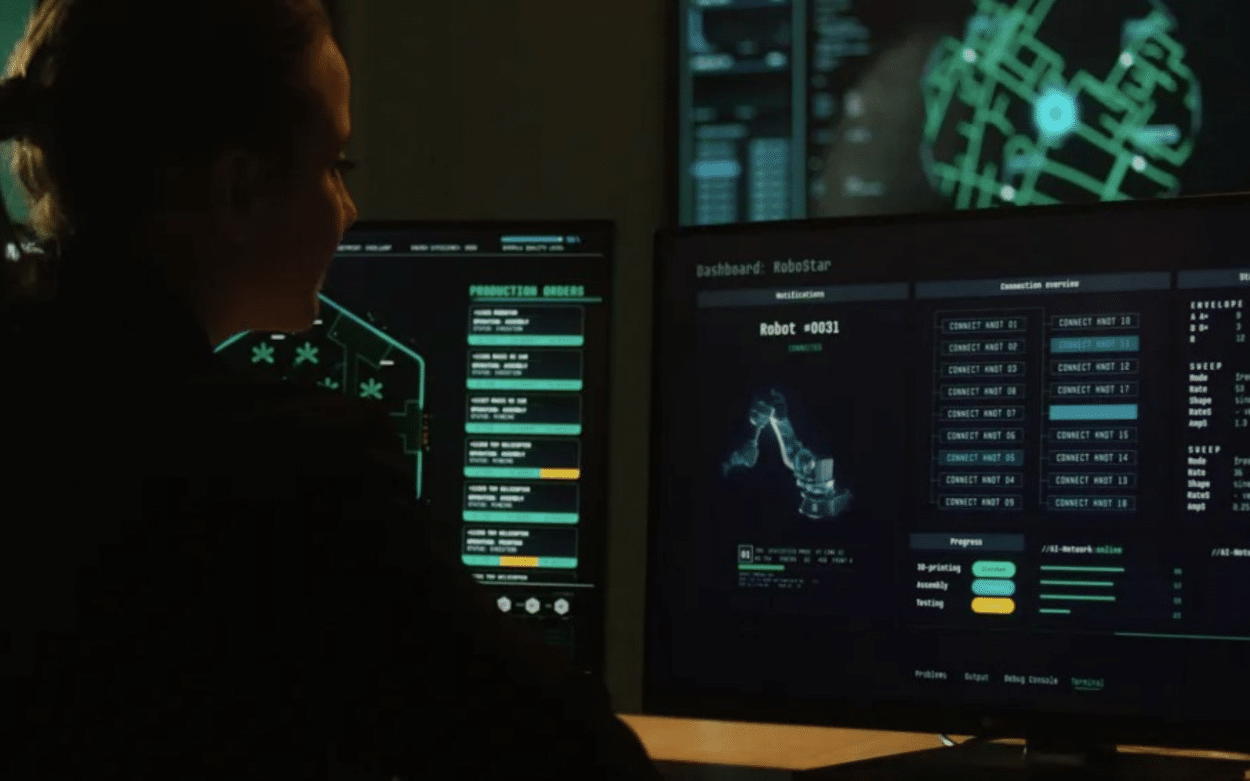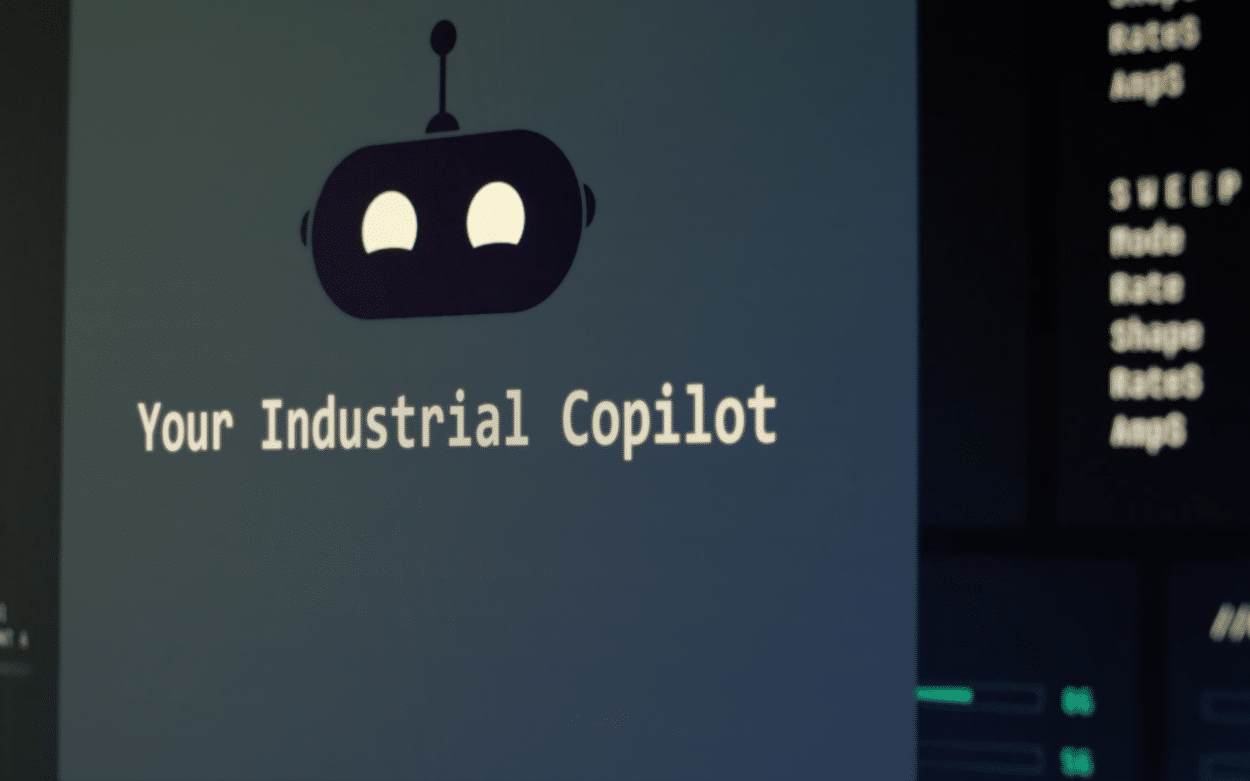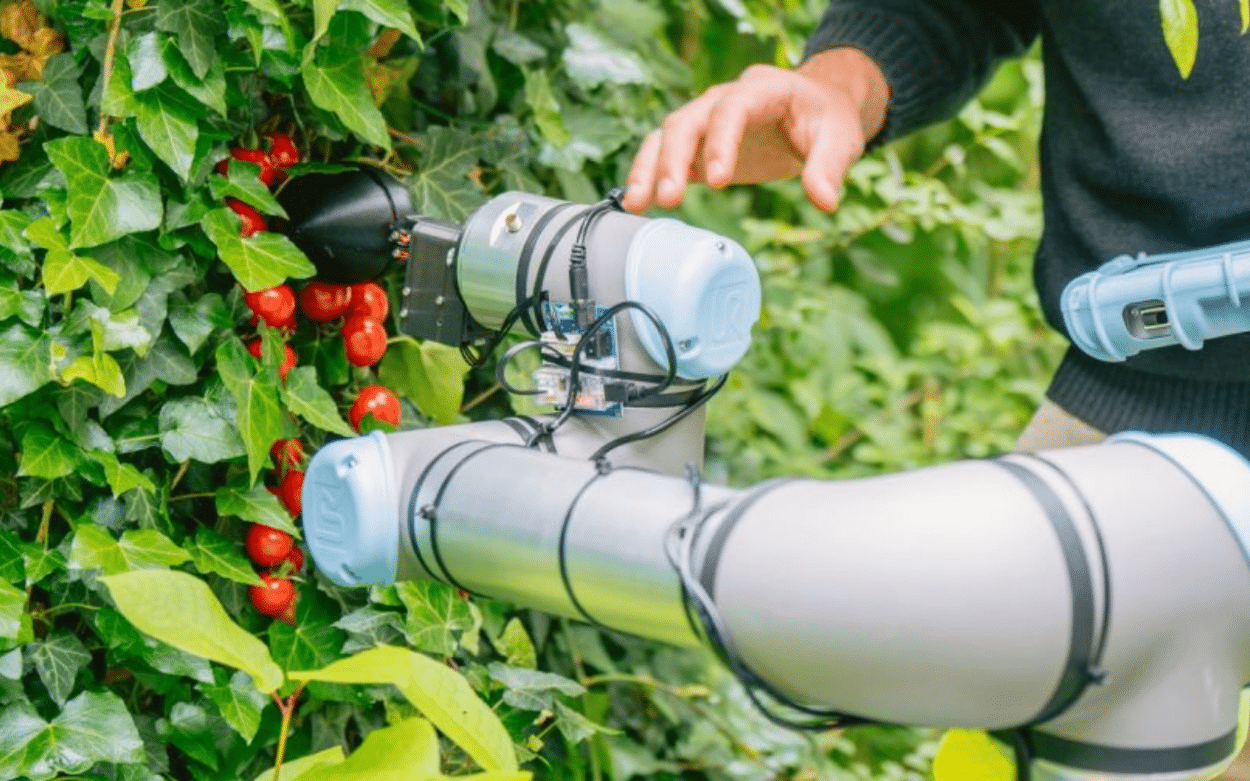ChatGPT has reached the one-year milestone and has already disrupted our lives at an unprecedented pace. Its advent has also unfolded new possibilities for industry. How have industrial players incorporated this technology over the past year? How have they translated its benefits into tangible outcomes for their operations? Does generative AI hold a genuine interest in industry? In this article, we explore insights from experts and observations at industrial trade shows. We also delve into the strategies envisioned by major corporations to leverage generative AI tools in an industrial context.
Daniel Allen, Adam Turner, Andrea Nepori, Hicham Dhouibi, and Camille Rustici contributed to this article.
One year ago, ChatGPT entered our lives unexpectedly, heralding a major technological revolution akin to those occurring once every century. It wasn’t just an evolution of the AI we had known in the industry for a long time. It marked the rise of generative AI, an AI trained on learning data to autonomously create original content. This content ranges from text to images, music, audio, and videos.
Generative AI brought Large Language Models (LLMs), deep learning algorithms capable of performing a variety of natural language processing tasks. This enables us to interact with machines in a manner akin to human conversation.
New professions, such as “prompt engineers,” have emerged swiftly, while others are on the verge of obsolescence. The entity behind ChatGPT, OpenAI, recently played a pivotal role in an international event two weeks ago, involving the departure of the board followed by the return of its leader, Sam Altman.
In one year, ChatGPT has become the virtual assistant for nearly the entire planet. We have sought to understand how such a revolution could impact industry and unfold on a factory-wide scale.
November 2022: A New Technology Is Born
In November 2022, the ChatGPT chatbot made its debut on the web, offering answers to users’ questions. Its highly convincing ability to simulate human conversations quickly made it indispensable. Today, millions of users employ it daily to request the generation of texts, articles, and computer programs.
During our initial conversation with ChatGPT, we asked it to introduce itself, and it responded:
“GPT (Generative Pre-trained Transformer) is a type of language generation model developed by OpenAI. It is a neural network-based model that uses machine learning techniques to generate natural language text that is similar to human writing. [It is] trained on a large dataset of human-generated text, such as books, articles, and websites. It uses this training data to learn the patterns and structures of language, and can then generate new text that is coherent and similar in style to the training data.”
At that time, experts like Emma Taylor, Associate Analyst at GlobalData, speculated on the potential effects of ChatGPT on the web:
“[ChatGPT] might be capable of challenging search engines such as Google. ChatGPT can supply entirely tailored and specific answers to very particular questions—all without ads—offering it an advantage over current search engines.”
2023: The Generative AI Race
In response to this disruption, the race among tech giants began. Microsoft first invested $1 billion in OpenAI, and gradually, ChatGPT was integrated into the Bing search engine.
In February, Google surprised everyone by announcing the launch of Bard, its AI-based chatbot directly competing with ChatGPT. Alphabet CEO Sundar Pichai introduced Bard in a blog post emphasizing its goal to combine the world’s knowledge with the power and intelligence of large language models.
“Bard seeks to combine the breadth of the world’s knowledge with the power, intelligence and creativity of our large language models. It draws on information from the web to provide fresh, high-quality responses.”
Today, the American leader unveiled Gemini to better compete against ChatGPT. Gemini can process large volumes of different types of information (text, code, audio, image, and video). Google plans to release a more advanced version of this chatbot early in 2024. It will first be available in English in 170 countries.
In China, the movement was underway, with Baidu planning to develop its own generative AI solution. Ernie, the rival to GPT-4, was officially launched in China last October.
The ambition to develop a European OpenAI is evident. In July, the French Minister of Economy Bruno Le Maire expressed the possibility that the European Union could build its own generative artificial intelligence system “within five years”.
In France, a trio of former Google and Meta employees didn’t wait. They launched Mistral AI in the spring, aiming to compete with ChatGPT and offer a credible alternative to American solutions. Mistral AI recently secured funding of €450 million, as reported by Bloomberg.
Last January, IBM’s CEO, Arvind Krishna, remarked:
“AI has become a big topic of conversation this year […] If I think about it, over the last decade, I think there were three moments you can talk about, […] One, when IBM won Jeopardy with Watson, […] Second, when deep mind from Google or Alphabet started winning competitions around, for example, GO […] and now with OpenAI and ChatGPT.”
Beyond enabling natural language responses to questions, what do tools like ChatGPT and generative AI bring to industry? Here are a few examples.
Assistants for Programming
Peter Fintl is the Vice President of Technology & Innovation at Capgemini Engineering. We interviewed him at Hannover Messe last April. According to him,
“The concept of Industry 4.0 originated from Hannover Messe, where we are currently present, a decade ago to leverage data to make better decisions, and predictions, and perform high-quality image recognition for inspections. As AI evolved, it emerged as a powerful tool to draw better conclusions than humans and predict potential failures in complex production chains. Today, advanced AI systems like ChatGPT are capable of serving as comprehensive intelligent assistants for everyone. This technology enables users to perform tedious and time-consuming tasks and supports their thinking processes, without replacing human cognitive abilities.”

For him, these systems are already finding applications in engineering life:
“Companies are working to integrate AI into real products. With AI-assisted programming and development tools, engineers and designers can boost their productivity and design more efficient and effective products. For instance, PLC programming can be performed with the help of an AI assistant, which will soon be a common feature across different areas of industrial production.”
Thales also wondered about how the generation of code could be replicated or leveraged.
The company, through its Thalès digital factory, embarked on creating technological tools for its employees. During the AI conference, AIM, in Marseille a few weeks ago, Virginie Galindo, Chief of Staff of Thales Digital Factory explained:
“We developed our own tools; the first one is a code assistant which assists developers through code, providing a companion in our development environments. The second one is an internal WeChat. We also work with OpenAI’s API since we have a privileged partnership with Microsoft, and thus, we had early access to this API.”
For Thalès the idea is to see where generative AI can help various roles within the company (engineers, designers, architects, developers…).
“Our hope, beyond performance, automation, etc., is primarily focused on creativity. That’s what we’re seeking—to enhance the creativity of individuals working for Thales.”
Co-Pilots for Industry
Prominent industry players like Siemens and Rockwell Automation have adapted the ChatGPT model for industrial applications. Both companies have developed co-pilots heavily inspired by the most famous chatbot, designed specifically for factory workers.
During the SPS trade show in November, Siemens showcased a tangible customer use case of generative AI in factory automation. Its Industrial Copilot, an AI-based digital assistant, functions as a ChatGPT for factory workers, as explained by Rainer Brehm:
“By generating PLC code through natural language input, the Industrial Copilot will enable automation engineers to create code more quickly. It will also help factory workers operate machines, providing support in areas such as fault diagnosis. This will reduce the time they need to spend developing and operating equipment, which is particularly important given the shortage of skilled workers.”



Rockwell Automation is also in the process of developing a ChatGPT-inspired Co-Pilot for Automation. They collaborated with Microsoft to integrate the Azure OpenAI Service into Rockwell’s FactoryTalk design studios. The goal is to assist Rockwell’s customers in building industrial automation systems in generating code using natural language prompts. This can also help engineers automate routine tasks and improve design efficiency. It is currently in the prototype stage.
In a demonstration at the Automation Fair in Boston last month, Adam Gregory, products manager at Rockwell Automation, explained:
“Let’s say I want to generate a simple code to control a pump. The LLM, the large language model, is not specifically trained in automation, but we at Rockwell do have that automation knowledge so we can provide our domain-specific language. And what you can see is that the generative AI was able to produce a code snippet for me on how to control a pump. Now, in this case, the generative AI has decided that the best way to do that is to use a latched and unlatched model.”
FactoryTalk Design Studios leverages the same LLM underlying ChatGPT 4.0 while enriching it with Rockwell’s knowledge. This information provides users with comprehensive and accurate responses tailored to the automation context.
Adam Gregory emphasized,
“This is meant to be a co-pilot, a partner programmer, not an autopilot. It’s not going to automate all of the project creation for you quite yet.”
Designing Cobots
Dr. Jochen Köckler, Chairman of Deutsche Messe, also shared his thoughts on the impact of ChatGPT on the industrial world. According to him, such tools can enable the control of industrial robots.
“Artificial intelligence systems such as ChatGPT, DALL-E, and Luminous from the German company Aleph Alpha can already help with texting, programming, and design. At Hannover Messe, Aleph Alpha, together with Hewlett Packard, will demonstrate how natural language can control an industrial robot.”
Controlling industrial robots using natural language tools, is okay. But why stop at control? Some have tested designing industrial robots with the assistance of ChatGPT and LLMs.

Researchers at TU Delft in the Netherlands explored the potential industrial applications of LLMs in co-developing cobots. For their experimentation, they chose tomato harvesting as the most economically valuable operation to automate.
They tackled the task in two phases. First, the computer and human collaboratively conceptualized the project, outlining specifications for the robot design. Then, the LLM assisted in the physical steps of programming the robot to achieve the desired result.
Thanks to the inputs from the LLMs, researchers, Assistant Professor Cosimo Della Santina, and Ph.D. student Francesco Stella said:
“When ChatGPT became available, we thought it was a great opportunity for a more solid analysis of their potential in the field of automation and if it could be used effectively for programming robots. We expected the system to help in the middle of the pipeline, automating the robot’s design. Instead, we saw that the system could support us from the beginning, even in the conceptual phase. It only stopped when things needed to be drawings and get physical, so we took the design back into our hands from there.”
ChatGPT contributed meaningful inputs about some key aspects of the robot’s development. For example, it suggested using a silicon gripper for handling tomatoes to “reduce the risk of crushing the crops”. It also proposed to pick a Dynamixel motor as the best actuator for a tomato-harvesting gripper.
The experiment was also meant to know if ChatGPT could help someone without previous knowledge of the field of automation. One of the latest trends in the sector is indeed to find ways to ease automation processes.
“We wanted to understand how far we could push the experiment, and we just made choices along the way, but always based on the options that ChatGPT gave us and the context it provided to help us choose. It put ChatGPT in the position of directing the outcome, rather than having an expert user manage the LLM as it would an assistant.”
The researchers concluded the experiment when they needed to proceed to the actual robot fabrication.
Addressing Production Issues
AI is also tackling more advanced manufacturing challenges. AI-powered language models, such as ChatGPT, are primarily focused on content production, but the underlying technology has applications far beyond.
This is what Reveal, a manufacturing enterprise software, offers. They employ AI akin to ChatGPT to identify variability at each production station and communicate necessary corrections to plant personnel. This technology aids manufacturers in promptly addressing production issues. It also provides them with recommendations for enhancing efficiency and consistency.
Cybersecurity: Improving Incident Response
Generative AI tools reinvent the dialogue between humans and machines and lower the expertise required. It removes barriers to control the machine, which is crucial in the face of cyber attackers.
For businesses to deal efficiently with cyber attackers will require a workforce of cybersecurity professionals that is impractical. Studies indeed suggest a global shortage of about four million professionals in the field. Generative AI tools could help compensate for this gap. Raphaël Marichez, Sales Director at American cybersecurity company Palo Alto Networks, believes it could enhance incident response management
“Generative AI can propose remediation solutions by examining, for example, the history of what you have done before. It might say, ‘I’ve seen this incident in your company five times, and you’ve proposed this remediation the last four times. Do you want to apply the same remediation this time? Yes, I click on Yes. Also, for the next time, do you want me to stop asking you this question? I’ll do it for you.”
For Mr. Marichez, this will save businesses a lot of time.
“It’s a real demand. Besides, [in Europe] GDPR requires companies to report personal data breaches within three days. Today, the average time to close the door on the attacker is six days. We have a problem; we need to reduce this delay.”
Generative AI could be the solution.










